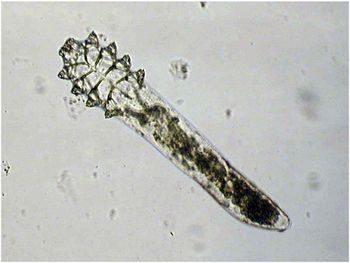Demodex folliculorum
Introduction
Demodex folliculorum are commensal mites that live in human hair follicles. D. folliculorum and D. Brevis are the only species in the Demodex genus that are found on humans, and are both referred to as “eyelash mites”. While D. brevis inhabit the sebaceous glands of hair follicles, D. folliculorum inhabits hair follicles themselves, particularly of eyelashes and eyebrows. Infants will acquire D. folliculorum shortly after birth from contact with other human hosts, however the lack of sebum production in young children prevents D. folliculorum from colonizing efficiently. As humans reach adulthood and continue to age, the infestation of D. folliculorum increases. The elderly and those suffering from immunodeficiency are particularly vulnerable to severe infestation and health risks posed by D. folliculorum including blepharitis.
[1].
Select a topic about genetics or evolution in a specific organism or ecosystem.
The topic must include one section about microbes (bacteria, viruses, fungi, or protists). This is easy because all organisms and ecosystems have microbes.
Compose a title for your page.
Type your exact title in the Search window, then press Go. The MicrobeWiki will invite you to create a new page with this title.
Open the BIOL 116 Class 2019 template page in "edit."
Copy ALL the text from the edit window.
Then go to YOUR OWN page; edit tab. PASTE into your own page, and edit.

At right is a sample image insertion. It works for any image uploaded anywhere to MicrobeWiki. The insertion code consists of:
Double brackets: [[
Filename: PHIL_1181_lores.jpg
Thumbnail status: |thumb|
Pixel size: |300px|
Placement on page: |right|
Legend/credit: Electron micrograph of the Ebola Zaire virus. This was the first photo ever taken of the virus, on 10/13/1976. By Dr. F.A. Murphy, now at U.C. Davis, then at the CDC.
Closed double brackets: ]]
Other examples:
Bold
Italic
Subscript: H2O
Superscript: Fe3+
Section 1 Genetics
The morphology of D. folliculorum shares many similarities to that of D. brevis. Adult D.folliculorum range from 0.3-0.4 mm in length and are composed of two fused body segments. Both segments are covered in scales and assist in anchoring to the hair follicle. The anterior segment has eight short legs attached that allow movement of 8-16 mm/h. Also on the anterior segment is the pin-like mouth that is specialized for eating sebum, skin cells, and hormones. The posterior segment contains a genital opening in both sexes. Rounder and shorter female mites mate with males on the opening of the hair follicle and undergo internal fertilization. Females lay their eggs inside the hair follicle, which hatch into six-legged larvae after 3-4 days and reach adulthood in 7 days. The full lifespan of D. folliculorum stretches over several weeks. The D. folliculorum mitochondrial genome is 14,150 base pairs long and on average 71% is made up of AT-pairs. The genome includes thirteen protein-encoding genes, two rRNA genes, and twenty-two tRNA genes. Its Genbank accession number is KM114226.
Include some current research, with at least one image.
Sample citations:
[2]
</ref>https://www.ncbi.nlm.nih.gov/pmc/articles/PMC3884930/</ref>
[3]
[4]
A citation code consists of a hyperlinked reference within "ref" begin and end codes.
Section 2 Microbiome
Include some current research, with a second image.
Conclusion
Overall text length should be at least 1,000 words (before counting references), with at least 2 images. Include at least 5 references under Reference section.
References
- ↑ https://www.sciencedirect.com/science/article/pii/S0738081X14000467
- ↑ https://www.sciencedirect.com/science/article/pii/S0738081X14000467
- ↑ Hodgkin, J. and Partridge, F.A. "Caenorhabditis elegans meets microsporidia: the nematode killers from Paris." 2008. PLoS Biology 6:2634-2637.
- ↑ Bartlett et al.: Oncolytic viruses as therapeutic cancer vaccines. Molecular Cancer 2013 12:103.
Edited by Scarlett Jones, student of Joan Slonczewski for BIOL 116 Information in Living Systems, 2019, Kenyon College.
